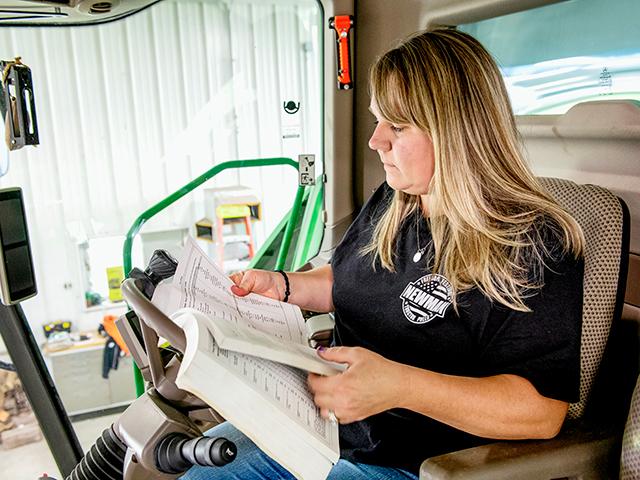Farmers Face Higher Diesel Fuel Costs
Increasing Diesel Prices Will Add Thousands of Dollars to Farmers' Costs
OMAHA (DTN) -- Diesel fuel prices are considerably higher for farmers this spring as they plant corn and soybean crops and get ready to harvest forage crops across the Corn Belt. As a result, these higher fuel prices are causing large increases in farmers' fuel budgets.
Diesel fuel prices hit a new high in May 2022 as the Ukraine war makes a tight fuel stocks situation worse. DTN recently wrote about this at https://www.dtnpf.com/….
DIESEL FUEL COSTS DOUBLE
But how do these higher prices affect farmers? Penn State University (PSU) Extension published an article recently titled "How Bad Is $6 Diesel for the Famer?" (https://extension.psu.edu/…)
Authors Andrew Frankenfield and Dwane Miller, both PSU Extension Educators, Agronomy, wrote about some of the particulars on how higher diesel fuel prices can affect farmers' bottom line. A cash grain farm using no-till and conventional fertilizer uses about 3 gallons per acre to grow and harvest a crop of corn or soybeans.
The diesel costs associated with trucking are not included in this estimate. Farms that use more tillage and/or those that spread manure will have higher fuel use per acre.
"Without question, higher diesel prices will increase your cost of production slightly," the authors wrote.
A price of $3/gallon and a fuel usage of 3 gallons/acre would cost a farmer $9/acre in diesel costs. Double the fuel price to $6/gallon and the fuel cost increases to $18/acre, a $9/acre increase.
P[L1] D[0x0] M[300x250] OOP[F] ADUNIT[] T[]
So, to a farmer with 500 acres of no-till corn and soybeans, this fuel increase would mean an additional $4,500 in fuel costs to produce the 2022 crop, they wrote.
Iowa State University (ISU) has done some research into the relative energy requirements per acre for corn and soybean acres, the pair wrote.
Taking into consideration such things for corn as drying, fertilizer, nitrogen fertilizer and field operations, ISU estimates it takes just under 35 gallons of diesel energy equivalent/acre. With soybeans only having some fertilizer and field operation costs, the number of gallons used in soybean production is only about seven gallons of diesel energy equivalent/acre.
HAY FUEL COSTS INCREASE
The PSU Extension Educators also looked at the increasing diesel costs to produce forage crops, specifically a hay crop.
According to research from ISU, it takes about 1.25 gallons of diesel to cut, rake and bale per acre. With $6/gallon diesel this year, it will cost the hay producer $7.50/acre per cutting, compared to about $3.75/acre per cutting last year.
The increase in fuel costs will really come into play when the hay grower goes to transport the hay. The cost of trucking per mile has gone up about $0.65 due to the nearly doubling of the fuel price in the past year, according to the authors.
"Consider that in your updated crop enterprise budget for 2022," he wrote. "Also, the increasing fuel price will continue to impact the cost of inputs used in agriculture and all industries for the foreseeable future."
NO RELIEF IN THE SHORT TERM
In a recent webinar titled "Dealing with Drought", Kansas State University Extension specialists answered questions from Kansas beef producers about different management practices during times of drought. (https://www.dtnpf.com/…)
One question was about diesel costs. Kansas State University Agricultural Economist Gregg Ibendahl said one interesting thing he noticed recently was how much more diesel has increased in price compared to gasoline. While both have increased drastically, diesel prices have increased at a higher pace than gasoline.
Considering where crude oil prices are currently, fuel prices should be about a $1/gallon lower, he said at the time.
Fuel refinery capacity during the beginning of the COVID-19 pandemic dropped significantly as the world closed and no one was driving much, he said. Refinery capacity has not increased enough to handle the increasing fuel demand, and this has led to skyrocketing fuel costs.
Ibendahl said fuel production is increasing but this will take some time to get diesel fuel prices to decline from current levels.
"I expect to see (diesel) prices stay high through this summer and then maybe by the time we get to next fall we could see prices decline some by then," Ibendahl said.
Russ Quinn can be reached at Russ.Quinn@dtn.com
Follow him on Twitter @RussQuinnDTN
(c) Copyright 2022 DTN, LLC. All rights reserved.



